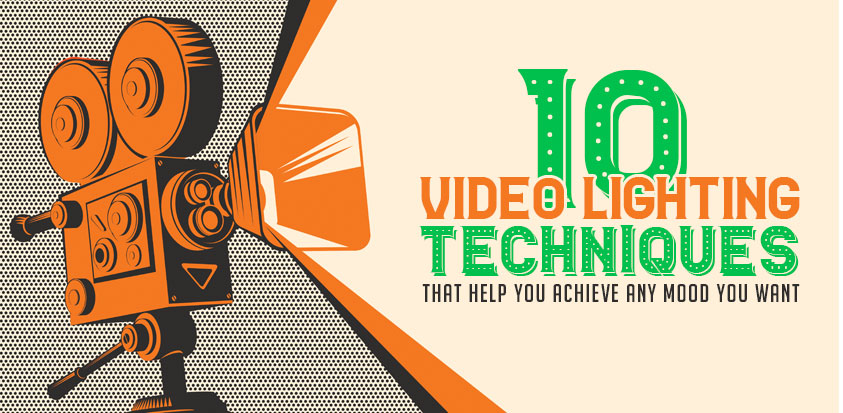While having a compelling story and a direct-to-the-point message can help you create a successful video campaign, overall visual can also leave a memorable impact on the viewers. This can be achieved through cinematography, which requires the appropriate cinematic shots as well as the right lighting techniques.
In fact, lighting can either make or break your video campaigns as it can change the way people or objects appear in the video. It also helps you direct the viewers’ eyes to the most important aspect of the frame.
Want to ensure you’re using the proper lighting for your advertising campaigns? Here are 10 video lighting techniques that can help you achieve any mood you want.
10 Different Video Lighting Techniques to Set the Mood for Your Advertising Campaigns
1. Three-Point Lighting
Three-point lighting is one of the most commonly used lighting techniques not only in advertisements but also in films and TV shows. As the name suggests, it involves three main types of lighting to illuminate the subject:
• Key Lighting
Key lighting focuses on the main person or object involved in a particular scene. It is the strongest and most prominent light seen in the frame. This type of lighting is usually placed in front of the subject but it can be placed on whichever side the subject’s facing.
Feel free to play around with this type of lighting to find the exact placement required for the scene. Do note, though, that even slight adjustments can change the look and mood of the video.
Tip: Avoid placing your key lighting near or right beside the camera as it can create a flat and direct light for your subject, which might be unappealing.
• Fill Lighting
While key lighting is bright enough to illuminate the subject, it can still leave dark areas in the scene. Fill lighting eliminates these dark shadows and is usually placed at the other side of the camera, opposite the key lighting.
When working with this type of lighting, make sure it does not overpower your key lighting as it can actually create shadows of its own. On the other hand, when it’s too light, it would not be able to fill all the dark areas.
• Backlighting
As the name implies, backlighting is placed behind the main subject. This helps the subject stand out from the environment and background, thus making the audience focus directly on a particular person or product.
Did You Know? If a backlight is placed behind an actor to highlight a specific feature, it’s called a kicker light.
2. Bounce Lighting
Bounce lighting refers to a technique that uses a reflector or any light-colored surfaces (such as ceilings, walls, or even whiteboard) to “bounce” the light and indirectly highlight a subject. This creates a large area of evenly spread light which can be used as a softer key, fill, or backlight.
3. Side Lighting
Also known as chiaroscuro lighting, this lighting technique illuminates a scene from the side, parallel to the subject. Side lighting is often used in creating drama or mood to a particular scene.
To achieve this lighting, you need a strong and contrasting light to accentuate the features of the subject. Make sure to diffuse it as it can provide harsh shadows.
4. Hard Lighting
Hard lighting is usually created by sunlight or a strong light source directed at a particular person or object. This lighting technique is usually unwanted because it can create harsh shadows but when done right, it can highlight your subject’s contour and ultimately draw attention to it.
5. Soft Lighting
Soft lighting does not really refer to any lighting direction or source, but it’s considered to be a technique nonetheless. It refers to an aesthetic used by both advertisers and filmmakers to eliminate shadows and replicate subtle lighting from exterior sources.
Tip: If you want to add youth to a subject’s face, you can incorporate soft lighting in a particular scene.
6. High Key Lighting
High key lighting is a style of lighting that is meant to create a very bright scene with minimal or no shadows, similar to overexposure. By reducing the lighting ratio found in the scene, this particular lighting technique can communicate a light, hopeful, and optimistic mood.
Did You Know? In the early days of film, high key lighting is used to improve high contrast ratios in a scene.
7. Low Key Lighting
In contrast to high key lighting, low key lighting refers to minimizing all the light sources to intentionally create a scene that has a lot of shadows. It typically uses only one strong key light source to illuminate the subject. This emphasizes drama, mystery, and suspense in a particular scene.
8. Natural Lighting
Natural lighting uses and modifies the light already available to you at a particular location. This can be sunlight, moonlight, street lamps, or even car headlights. As such, this particular lighting technique doesn’t require you to move any light sources which ultimately cut the time needed for professional lighting set-up.
Having said that, you still need to consider the time of the day and the actual location where you’ll be shooting. You can then decide on what particular gear (such as light modifiers or reflectors) you might need to adjust the lighting based on a particular scene.
Tip: If you want to use natural lighting for your commercial campaigns, it’s best to shoot during the “magic hour” or the time just before the sun sets.
9. Practical Lighting
This type of lighting technique primarily makes use of set dressing or props such as candles, lamps, or even the television to illuminate the subject. These are usually intentionally added by the lighting crew or set designers to set a specific mood or ambiance.
Tip: Practical lights, especially candles and lamps, are not enough on their own to light up a subject. It’s best to use a hidden, motivated light to properly illuminate the scene.
10. Motivated Lighting
Motivated lighting simply refers to a lighting technique that imitates natural light sources such as the sun, moon, streetlights, and even car headlights. It is also a type of lighting that enhances the intensity and coverage of practical lights by using a separate, often hidden, light source.
If you do incorporate this lighting technique, though, make sure it looks as natural as possible. You can do this by using colored gels to replicate the warm light coming from the sun or the faint blue light from the moon. You can also utilize filters to imitate window shadows.
ALSO READ: Video Production for Beginners: 8 Videography Tricks from the Pros
Lighting is essential in every kind of video, whether it’s for an advertisement or film. It can direct the viewers’ eyes on what is important in the scene. It can also change how the subject appears. Learn these 10 video lighting techniques to set the proper mood for your videos.
Want to ensure you have the proper lighting for your video campaigns? Work with a reputable video production company in the Philippines, Mustasa Republic. Backed with years of experience in the video industry, we are committed to producing cinematic campaigns that would drive viewership and boost sales. Contact us today to learn more!
Enjoyed reading this article? Follow our blog for more video production tips.

